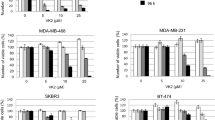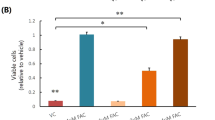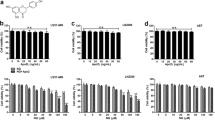Abstract
Congeners of vitamin K have been found to inhibit growth in various rodent and human tumor cells, but the mechanisms of the inhibitory action are still not well understood. To investigate the modes of actions of vitamin K, we used several vitamin K analogs and examined their cytotoxic effect for human glioma cell lines RBR17T and U251. The analogs included vitamin K1 (VK1), vitamin K2 (VK2), vitamin K3 (VK3), and geranylgeraniol (GGO) which form an unsaturated side chain of VK2. Cell viability was estimated by MTT assay. DNA fragmentation was demonstrated by gel electrophoresis and flow cytometry. In order to study the mechanism of apoptosis, we measured the changes of intracellular reactive oxygen intermediates (ROI) and Fas/APO-1 expression by flow cytometry. The results showed: (1) VK2, VK3, and GGO inhibited cell growth; (2) VK3 had a more potent cytotoxic effect than VK2, and VK3 enhanced the cytotoxic effect of antitumor agents (ACNU and IFN-beta) in RBR17T cells; (3) VK2, VK3, and GGO induce apoptosis; (4) VK3 increased the expression of Fas/APO-1 although VK2 and GGO did not increase its expression in glioma cells; (5) VK3 increased the production of intracellular ROI. Catalase and reduced glutathione (GSH) inhibited production of intracellular ROI and antagonized inhibition of cell-growth induced by VK2, but failed to antagonize that of VK2 and GGO. We hypothesize that VK3 induces apoptosis by promoting the generation of intracellular ROI and Fas/APO-1 expression. On the other hand, VK2 and GGO induce apoptosis but most likely by some other unknown pathway.
Similar content being viewed by others
References
Furie B, Furie BC: Molecular basis of Vitamin K-dependent r-carboxylation. Blood 75: 1753-1762, 1990
Prasad KN, Edwards-Prasad J, Sakamoto A: Vitamin K3 (menadione) inhibits the growth of mammalian tumor cells in culture. Life Sci 29: 1387-1392, 1981
Nutter LM, Cheng AL, Hung HL, Hsieh RK, Ngo EO, Liu TW: Menadione: spectrum of anticancer activity and effects on nucleotide metabolism in human neoplastic cell lines. Biochem Pharmacol 41: 1283-1292, 1991
Wu FY, Liao WC, Chang HM: Comparison of antitumor activity of vitamins K1, K2 and K3 on human tumor cells by two (MTT and SBR) cell viability assays. Life Sci 52: 1797-1804, 1993
Ni R, Nishikawa Y, Carr BI: Cell growth inhibition by a novel Vitamin K is associated with induction of protein tyrosine phosphorylation. J Biol Chem 273: 9906-9911, 1998
Wu FY, Chang NT, Chen WJ, Juan CC: Vitamin K3-induced cell cycle arrest and apoptotic cell death are accompanied by altered expression of c-fos and c-myc in nasopharyngeal carcinoma cells. Oncogene 8: 2237-2244, 1993
Nishikawa Y, Carr BI, Wang M, Kar S, Finn F, Dowd P, Zheng ZB, Kerns J, Naganathan S: Growth inhibition of hepatoma cells induced by Vitamin K and its analogs. J Biol Chem 270: 28304-28310, 1995
Bouzahzah B, Nishikawa Y, Simon D, Carr RI: Growth control and gene expression in a new hepatocellular carcinoma cell line, Hep 40: inhibitory actions of Vitamin K. J Cell Physiol 165: 459-467, 1995
Wang Z, Wang M, Finn F, Carr BI: The growth inhibitory effects of vitamins K and their actions on gene expression. Hepatology 22: 876-882, 1995
Yaguchi M, Miyazawa K, Katagiri T, Nishimaki J, Kizaki M, Tohyama K, Toyama K: Vitamin K2 and its derivatives induce apoptosis in leukemia cells and enhance the effect of all-trans retinoic acid. Leukemia 11: 779-787, 1997
Sun LK, Yoshii Y, Miyaki K, Ishida A: Proliferation inhibition of glioma cells by Vitamin K2. Neurol Surg 27: 119-125, 1999
Beglciter A: Cytocidal action of the quinone group and its relationship to antitumor activity. Cancer Res 43: 481-484, 1983
Nutter LM, Ngo EO, Fisher GR, Gutierrez PL: DNA strand scission and free radical production in menadionetreated cells. Correlation with cytotoxicity and role of NADPH quinone acceptor oxidoreductase. J BiolChem 267: 2474-2479, 1992
Suhara T, Fukuo K, Sugimoto T, Morimoto S, Nakahashi T, Hata S, Shimizu M, Ogihara T: Hydrogen peroxide induces up-regulation of Fas in human endothelial cells. J Immunol 160: 4042-4047, 1998
Vogt M, Bauer MKA, Ferrari D, Schulze-Osthoff K: Oxidative stress and hypoxia/reoxygenation trigger CD95(APO-1/Fas) ligand expression in microglial cells. FEBS Letters 429: 67-72, 1998
Schulze-Osthoff K, Los M, Baeuerle PA: Redox signalling by transcription factors NF-kappa B and AP-1 in lymphocytes. Biochem Pharmacol 50: 735-741, 1995
Barchowsky A, Munro SR, Morana SJ, Vincenti MP, Treadwell M: Oxidant-sensitive and phosphorylationdependent activation of NF-kappa B and AP-1 in endothelial cells. Am J Physiol 269: L829-L836, 1995
Jordan JP, Hand CM, Markowitz RS, Black P: Test for chemotherapeutic sensitivity of cerebral glioma: use of colorimetric MTT assay. J Neuro-Oncol 14: 19-35, 1992
Gong J, Traganos F, Darzynkiewicz Z: A selective procedure for DNA extraction from apoptotic cells applicable for gel electrophoresis and flow cytometry. Anal Biochem 218: 314-319, 1994
Vowells SJ, Sekhsaria S, Malech HL, Shalit M, Fleisher TA: Flow cytometric analysis of the granulocyte respiratory burst: a comparison study of fluorescent probes. J Immunol Methods 178: 89-97, 1995
Gold J: In vivo synergy of Vitamin K3 and methotrexate in tumor-bearing animals. Cancer Treat Rep 70: 1433-1435, 1986
Mirowski M, Rozalski M, Krajewska U, Hanausek M, Wierzbicki R: Expression of 65-kDa oncofetal protein in experimental hepatoma after anticancer therapy. Neoplasma 44: 85-89, 1997
Takami A, Nakao S, Ontachi Y, Yamauchi H, Matsuda T: Successful therapy of myelodysplastic syndrome with menatetrenone, a vitamin K2 analog. Int J Hematol 69: 24-26, 1999
Ohizumi H, Masuda Y, Nakajo S, Sakai I, Ohsawa S, Nakaya K: Geranylgeraniol is a potent inducer of apoptosis in tumor cells. J Biochem 117: 11-13, 1995
Sakai I, Hashimoto S, Yoda M, Hida T, Ohsawa S, Nakajo S, Nakaya K: Novel role of Vitamin K2: a potent inducer of differentiation of various human myeloid leukemia cell lines. Biochem Biophys Res Commun 205: 1305-1310, 1994
Rieger J, Naumann U, Glaser T, Ashkenazi A, Weller M: APO2 ligand: a novel lethal weapon against malignant glioma? FEBS Letters 427: 124-128, 1998
Weller M, Malipiero U, Rensing-Ehl A, Barr PJ, Fontana A: Fas/APO-1 gene transfer for human malignant glioma. Cancer Res 55: 2936-2944, 1995
Fulda S, Susin SA, Kroemer G, Debatin KM: Molecular ordering of apoptosis induced by anticancer drugs in neuroblastoma cells. Cancer Res 58: 4453-4460, 1998
Friesen C, Herr I, Krammer PH, Debatin KM: Involvement of the CD95(APO-1/Fas) receptor/ligand system in drug-induced apoptosis in leukemia cells. Nat Med 2: 574-577, 1996
Akman SA, Dietrich M, Chlebowski R, Limberg P, Block JB: Modulation of cytotoxicity of menadione sodium bisulfates versus leukemia L1210 by the acid-soluble thiol pool. Cancer Res 45: 5257-5262, 1985
Talcott RE, Ketterman A, Giannini DG: Inactivation of microsomal NADPH-cytochrome C reductase by sulfhydryl-reactive derivatives of menadione. Biochem Pharmacol 33: 2663-2668, 1984
Juan CC, Wu FY: Vitamin K3 inhibits growth of human hepatoma HepG2 cells by decreasing activities of both p34cdc2 kinase and phosphatase. Biochem Biophys Res Commun 190: 907-913, 1993
Garrison JI, Berens ME, Shapior JR, Treasurywala S, Floyd Smith G: Interferon-beta inhibits proliferation and progression through S phase of cell cycle in five glioma cell lines. J Neuro-Oncol 30: 213-223, 1996
Ushio Y, Kochi M, Kitamura I, Kuratsu J: Ventriculolumbar prefusion of 3-[(4-amino-2-methyl-5-pyrimidinyl)-methyl]-1-(2-chloroethyl)-1-nitrosourea hydrochloride for subarachnoid dissemination of gliomas. J Neuro-Oncol 38: 207-212, 1998
Author information
Authors and Affiliations
Rights and permissions
About this article
Cite this article
Sun, LK., Yoshii, Y. & Miyagi, K. Cytotoxic Effect through Fas/APO-1 Expression due to Vitamin K in Human Glioma Cells. J Neurooncol 47, 31–38 (2000). https://doi.org/10.1023/A:1006443422488
Issue Date:
DOI: https://doi.org/10.1023/A:1006443422488




